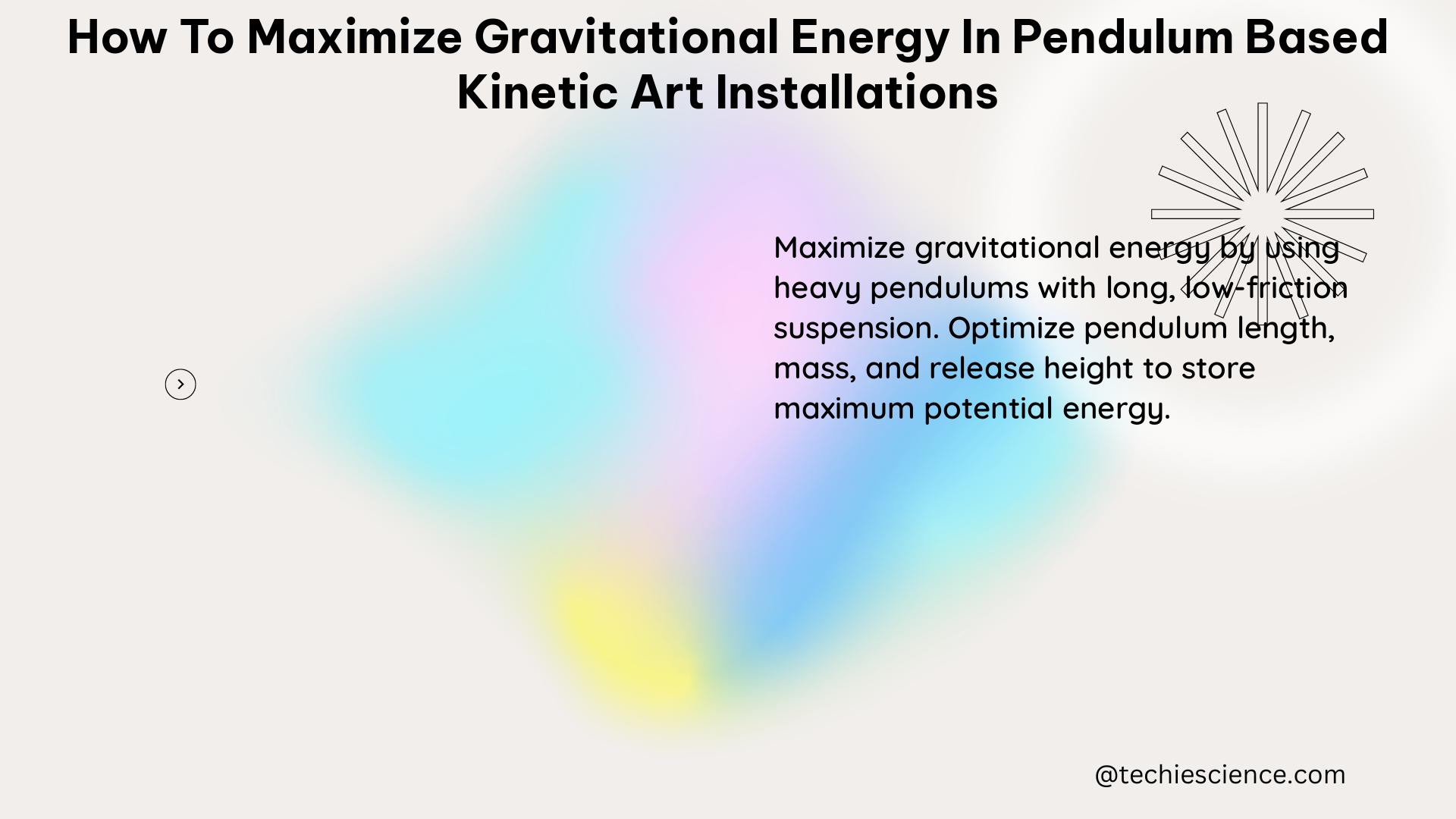Summary
To maximize the gravitational energy in a pendulum-based kinetic art installation, you need to focus on increasing the potential energy at the highest point of the swing. This can be achieved by adjusting the length of the pendulum, the angle of release, and the mass of the pendulum bob. By understanding these factors and their impact on the pendulum’s motion, you can create more engaging and visually striking installations.
Pendulum Length (L)

The length of the pendulum directly affects the maximum potential energy it can attain. According to the formula for the period of a simple pendulum, T = 2π√(L/g), where g is the acceleration due to gravity, increasing the length of the pendulum will increase the time it takes to complete one swing, and thus the maximum potential energy.
For example, if the length of the pendulum is doubled, the period of the pendulum will increase by a factor of √2, and the maximum potential energy will also increase by a factor of √2. This is because the potential energy of a pendulum is directly proportional to the height of the pendulum bob above its equilibrium position, which is determined by the length of the pendulum.
However, it’s important to note that a longer pendulum may require more space and could be more susceptible to external factors affecting its motion, such as air resistance or disturbances. Therefore, finding the optimal length for your installation is crucial to balance the desired visual effect and practical considerations.
Angle of Release (θ)
The angle at which the pendulum is released from its highest point also plays a crucial role in maximizing its potential energy. The maximum potential energy is achieved when the pendulum is released at an angle of θ = 180°, which is directly above the pivot point. At this angle, the pendulum bob has the greatest height above the equilibrium position, and thus the maximum potential energy.
To calculate the potential energy of a pendulum at any angle θ, you can use the formula:
PE = mgh = mg * L * (1 - cos(θ))
where m is the mass of the pendulum bob, g is the acceleration due to gravity, L is the length of the pendulum, and θ is the angle of the pendulum from the vertical.
However, releasing the pendulum at such a large angle may not be practical for some installations, as it could interfere with the desired visual effect or the physical constraints of the space. In such cases, finding the right balance between the angle of release and the desired visual effect is essential.
Mass of the Pendulum Bob (m)
The mass of the pendulum bob affects the kinetic energy of the pendulum but not its potential energy, as potential energy is dependent on height and not mass. Therefore, changing the mass of the pendulum bob will not directly affect the maximum potential energy it can attain.
The kinetic energy of a pendulum is given by the formula:
KE = 1/2 * m * v^2
where m is the mass of the pendulum bob and v is the velocity of the pendulum bob.
A heavier pendulum bob will result in a greater kinetic energy and thus a more noticeable visual effect when the pendulum is in motion. This is because the increased mass will lead to a greater momentum, which will be more apparent in the pendulum’s swing.
However, it’s important to consider the practical limitations of the installation, such as the strength of the supporting structure and the overall weight of the pendulum. Choosing the appropriate mass for the pendulum bob is crucial to ensure the stability and safety of the installation.
Optimization Strategies
To maximize the gravitational energy in a pendulum-based kinetic art installation, you can consider the following optimization strategies:
- Maximize Pendulum Length: Increase the length of the pendulum to the maximum extent possible, while considering the available space and practical constraints.
- Optimize Angle of Release: Aim to release the pendulum at an angle as close to 180° as possible, but balance this with the desired visual effect and practical limitations.
- Adjust Pendulum Bob Mass: Experiment with different masses for the pendulum bob to find the optimal balance between visual impact and practical considerations.
- Minimize Friction and Damping: Reduce sources of energy dissipation, such as air resistance and bearing friction, to maximize the pendulum’s swing and potential energy.
- Incorporate Resonance: If possible, design the installation to take advantage of the pendulum’s natural resonance frequency, which can amplify the swing and potential energy.
- Utilize Counterweights: Consider adding counterweights to the pendulum system to further increase the potential energy and visual impact.
By applying these optimization strategies and understanding the underlying physics principles, you can create pendulum-based kinetic art installations that maximize the gravitational energy and deliver a captivating visual experience.
Reference:
- Pendulum Motion Physics Tutorial
- Energy in a Pendulum | Gary Garber’s Blog
- Potential & Kinetic Energy of a Pendulum | Overview & Examples

The lambdageeks.com Core SME Team is a group of experienced subject matter experts from diverse scientific and technical fields including Physics, Chemistry, Technology,Electronics & Electrical Engineering, Automotive, Mechanical Engineering. Our team collaborates to create high-quality, well-researched articles on a wide range of science and technology topics for the lambdageeks.com website.
All Our Senior SME are having more than 7 Years of experience in the respective fields . They are either Working Industry Professionals or assocaited With different Universities. Refer Our Authors Page to get to know About our Core SMEs.